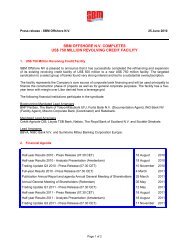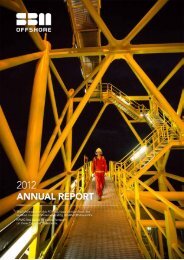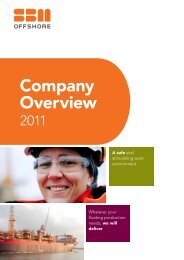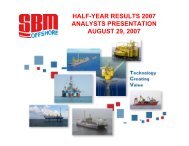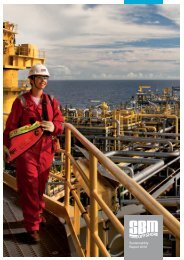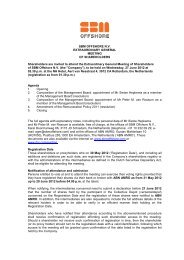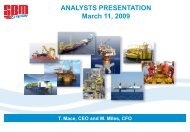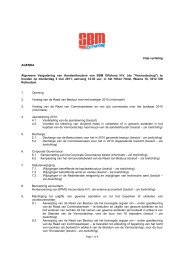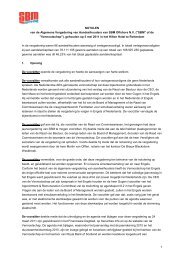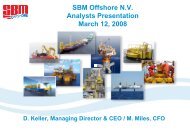Annual Report 2010 - SBM Offshore
Annual Report 2010 - SBM Offshore
Annual Report 2010 - SBM Offshore
You also want an ePaper? Increase the reach of your titles
YUMPU automatically turns print PDFs into web optimized ePapers that Google loves.
<strong>Report</strong> of the Board of Management<br />
Operational<br />
Project execution<br />
The Company provides custom built solutions according<br />
to clients’ requirements. Project Risk workshops are<br />
conducted from the proposal phase through to project<br />
completion by experienced personnel to highlight the<br />
novel aspects and assure good Risk Management on<br />
all subjects critical to each project’s success. A key<br />
objective of Project Risk Assessments is to reduce the<br />
variability of Project outcomes/results.<br />
The Company makes HSSE protection a high priority<br />
in the execution of its projects and minimising the<br />
occurrence of HSSE events is addressed by:<br />
• the application of continually upgraded HSSE<br />
standards;<br />
• risk based reviews of operations by HSSE<br />
professionals;<br />
• internal health and safety staff advise line management<br />
as necessary to minimise the level of risk to<br />
employees;<br />
• security issues relating to specific geographical<br />
risks are identified and mitigating plans developed<br />
in accordance with, in the case of the offshore fleet,<br />
the International Ship & Port Facility Security (ISPS)<br />
Code and for onshore locations, in country security<br />
and Journey Management plans.<br />
The technical challenges of each project are<br />
addressed by:<br />
• employing and developing in-house expertise and<br />
external advice when appropriate;<br />
• strict adherence to the Group Management System,<br />
HSSE standards, Corporate Engineering Standards<br />
and Quality Assurance Procedures;<br />
• review by, and compliance with, the requirements of<br />
the relevant Classification Society;<br />
• including provisions in cost estimates and contingencies<br />
for particular commercial, technical, and<br />
execution challenges based on a thorough assessment<br />
of the inherent risks.<br />
Significant technical, commercial and contractual risks<br />
are identified and recorded on a Risk Register by key<br />
personnel and reviewed in workshops.<br />
90 <strong>SBM</strong> <strong>Offshore</strong> – <strong>Annual</strong> <strong>Report</strong> <strong>2010</strong><br />
Execution risk is controlled through on-going monitoring<br />
during the construction, installation and start-up<br />
phases. A detailed monthly reporting and forecast<br />
procedure is used to anticipate and prevent execution<br />
delays and budget overrun. The consequences<br />
of accidental events encountered in execution are<br />
insured under comprehensive Construction All Risk<br />
(C.A.R.) insurance policies. The financial viability<br />
verification process is being strengthened for clients,<br />
major vendors and subcontractors and a tendering<br />
process is applied to procure quality equipment at<br />
competitive prices.<br />
A key element of the cost control strategy is to own and<br />
control adequate means for the offshore installation of<br />
the floating systems, in the shape of the Company’s<br />
installation vessels. This provides protection from the<br />
non-availability and the cyclically high pricing of third<br />
party contractors. The decision to invest in a new, versatile<br />
installation vessel will enable this strategy to be<br />
pursued in the medium to long-term.<br />
The Company maintains an inventory of tankers for<br />
conversion projects in the future. This allows the<br />
Company to improve the accuracy of the estimated<br />
costs of a future project by using a firm price for the hull<br />
and detailed knowledge of the required refurbishment<br />
and conversion work for the hull.<br />
The Company operates globally from different centres<br />
and the continuity of operations from each of the<br />
principal locations is addressed by plans setting out<br />
appropriate responses to major potential events such<br />
as fire and re-establishing key functions efficiently<br />
including IT. The ability to work from any of the main<br />
execution centres using the same tools and systems is<br />
an important strength.<br />
Production operations<br />
The lease and operation of offshore production units<br />
brings other risks including environmental, performance,<br />
health, security & safety risks, each requiring<br />
identification, assessment and management.<br />
Environmental<br />
No major environmental incident involving FPSOs or<br />
FSOs has occurred anywhere in the world although



